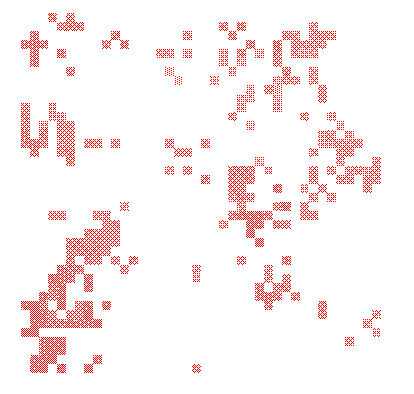
Even though herbivorous spider mites are so small that they are difficult to see with the naked eye, the damage they cause is dreaded by those who keep plants in the window-sill and, of course, by growers. While becoming covered with a sticky web, plants get a wilted, yellowish appearance and if nothing is done about it, the plants soon die. In the home spider mites are a nuisance, but in agriculture they may constitute a serious economic problem.
One of the ways to combat spider mites is to release predatory mites. Under the favourable conditions of a large prey population, predatory mites multiply fast and within days or weeks there is a large population of predators, rapidly decimating the spider mites. In a glasshouse, biological control using predatory mites is often so effective that it results in the complete extermination of the prey. To the grower this is a bonus, but to an ecologist it poses an important question. Why do prey and predators go extinct? Why do the predators overexploit their own means of subsistence? Questions like these are not only of academic interest. Repeated release of predatory mites may be feasible in a glasshouse, in other cases biological control hinges upon the ability of predators to keep their prey at a low level while not exterminating it. This is not an impossible aim. Many organisms that cause damage in agriculture are kept in check by natural enemies in their original habitat. Apparently prey and predators do persist in their natural habitat, but how is still an unresolved issue.
Ecologists have formulated and analysed many models for the interaction of predator and prey, to assess how persistence is affected by various "factors", like spatial structure of the environment, the presence of alternative food sources for the predators, the presence of refuges for the prey, and so on. From such exercises it has become clear that persistence is by no means an inevitable outcome—there is no such law as "the ecological equilibrium of prey and predator is always stable"—because oscillations of predator and prey may become so violent that eventually one or both of the populations dies out. Furthermore it has become clear that the population dynamical outcome may strongly depend on the properties of prey and predators. For example, in biological control it can make a large difference whether predators specialize on the pest species, or whether they also consume other food sources.
In this thesis, one will find no practical directives for how to carry out biological control programs. Indeed, one will not find many references to mites, even though mite predator-prey systems originally provided the impetus for the research. Instead, the chapters deal interacting populations in a variety of settings. What unifies the chapters is the approach rather than the subject: the attempt to integrate population dynamical analysis and evolutionary theory.
A population dynamical model is the combination of a set of rules describing the behaviour of individuals and a bookkeeping mechanism to keep track of population sizes over time. Usually, the set of rules describing individual behaviour is based on assumptions, and this confers a certain arbitrariness to the model; even when observations or experiments underlie the assumptions, uncertainty often makes it necessary to allow quite a margin. When population dynamical analysis is combined with evolutionary theory, one can replace assumptions by an evolutionary argument. This way, one can form hypotheses about population dynamics that will result if populations are subject to natural selection.